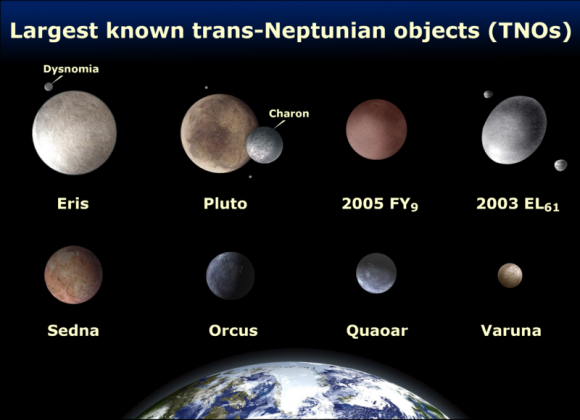Let’s find out why Pluto is no longer considered a planet.
Pluto was first discovered in 1930 by Clyde W. Tombaugh at the Lowell Observatory in Flagstaff Arizona. Astronomers had long predicted that there would be a ninth planet in the Solar System, which they called Planet X. Only 22 at the time, Tombaugh was given the laborious task of comparing photographic plates. These were two images of a region of the sky, taken two weeks apart. Any moving object, like an asteroid, comet or planet, would appear to jump from one photograph to the next.
After a year of observations, Tombaugh finally discovered an object in the right orbit, and declared that he had discovered Planet X. Because they had discovered it, the Lowell team were allowed to name it. They settled on Pluto, a name suggested by an 11-year old school girl in Oxford, England (no, it wasn’t named after the Disney character, but the Roman god of the underworld).
After a year of observations, Tombaugh finally discovered an object in the right orbit, and declared that he had discovered Planet X. Because they had discovered it, the Lowell team were allowed to name it. They settled on Pluto, a name suggested by an 11-year old school girl in Oxford, England (no, it wasn’t named after the Disney character, but the Roman god of the underworld).
The Solar System now had 9 planets.
Astronomers weren’t sure about Pluto’s mass until the discovery of its largest Moon, Charon, in 1978. And by knowing its mass (0.0021 Earths), they could more accurately gauge its size. The most accurate measurement currently gives the size of Pluto at 2,400 km (1,500 miles) across. Although this is small, Mercury is only 4,880 km (3,032 miles) across. Pluto is tiny, but it was considered larger than anything else past the orbit of Neptune.
Over the last few decades, powerful new ground and space-based observatories have completely changed previous understanding of the outer Solar System. Instead of being the only planet in its region, like the rest of the Solar System, Pluto and its moons are now known to be just a large example of a collection of objects called the Kuiper Belt. This region extends from the orbit of Neptune out to 55 astronomical units (55 times the distance of the Earth to the Sun).
Astronomers estimate that there are at least 70,000 icy objects, with the same composition as Pluto, that measure 100 km across or more in the Kuiper Belt. And according to the new rules, Pluto is not a planet. It’s just another Kuiper Belt object.

Here’s the problem. Astronomers had been turning up larger and larger objects in the Kuiper Belt. 2005 FY9, discovered by Caltech astronomer Mike Brown and his team is only a little smaller than Pluto. And there are several other Kuiper Belt objects in that same classification.
Astronomers realized that it was only a matter of time before an object larger than Pluto was discovered in the Kuiper Belt.
 And in 2005, Mike Brown and his team dropped the bombshell. They had discovered an object, further out than the orbit of Pluto that was probably the same size, or even larger. Officially named 2003 UB313, the object was later designated as Eris. Since its discovery, astronomers have determined that Eris’ size is approximately 2,600 km (1,600 miles) across. It also has approximately 25% more mass than Pluto.
And in 2005, Mike Brown and his team dropped the bombshell. They had discovered an object, further out than the orbit of Pluto that was probably the same size, or even larger. Officially named 2003 UB313, the object was later designated as Eris. Since its discovery, astronomers have determined that Eris’ size is approximately 2,600 km (1,600 miles) across. It also has approximately 25% more mass than Pluto.
With Eris being larger, made of the same ice/rock mixture, and more massive than Pluto, the concept that we have nine planets in the Solar System began to fall apart. What is Eris, planet or Kuiper Belt Object; what is Pluto, for that matter? Astronomers decided they would make a final decision about the definition of a planet at the XXVIth General Assembly of the International Astronomical Union, which was held from August 14 to August 25, 2006 in Prague, Czech Republic.
Astronomers from the association were given the opportunity to vote on the definition of planets. One version of the definition would have actually boosted the number of planets to 12; Pluto was still a planet, and so were Eris and even Ceres, which had been thought of as the largest asteroid. A different proposal kept the total at 9, defining the planets as just the familiar ones we know without any scientific rationale, and a third would drop the number of planets down to 8, and Pluto would be out of the planet club. But, then… what is Pluto?
In the end, astronomers voted for the controversial decision of demoting Pluto (and Eris) down to the newly created classification of “dwarf planet”.
Read more: http://www.universetoday.com/13573/why-pluto-is-no-longer-a-planet/
http://www.universetoday.com/13573/why-pluto-is-no-longer-a-planet/#ixzz362ZrUYtc


